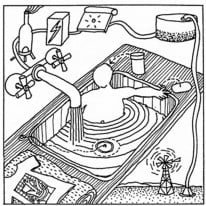C7 - Communications

Access to telecommunications can be important for contacting emergency services in relation to safety and health, as well as a way of maintaining cultural, family, social and economic obligations. The current number of fixed telephone residential connections in remote Indigenous housing is extremely low by comparison with the wider Australian situation. For example, the service take-up rate amongst residents in remote Northern Territory Indigenous communities when surveyed in 2002 was estimated at 1.5% (Department of Communications Information Technology and the Arts 2002) compared to about 38% Australia wide.
Further, access to public telephone services is limited. In 2002, only 267 of 1002 small Indigenous communities with a population of fewer than 50 had a payphone[1]. However, in addition to the safety factors involved, more facilities are being introduced to encourage the uptake of residential services. These include:
- Country Calling Line, a Telstra low rental residential product that requires calls to all but 000 and some 1800 free call destinations to be made using a pre-paid phone-card;
- Extended zone calling, whereby calls within and between adjoining calling zones in remote Australia are untimed and are charged at the local call rate. (Extended zones cover about 80% of Australia’s land mass and range between 8,000 and 300,000 square kilometres in area.)
- A delayed hotline feature, whereby a residential caller is connected through to a pre-programmed number without needing to dial.
For new housing, ensure that provision is made for residents to have the phone connected. It is recommended that facility cabling with at least two phone access sockets should be provided in each new or refurbished dwelling, to provide residents with some flexibility in the location of their phones. External cabling will normally be provided by the telecommunications carrier to extend the connection from their network to one of these sockets. Where a group of houses is being built or undergoing a major refurbishment, the provision of network cabling in the area should be coordinated with the carrier.
At a community level, ensure that public phones are accessible and reliable, and that they are in a safe location.
If the community has difficulty accessing phone services, they may be able to get assistance by contacting the Telecommunications Industry Ombudsman who can enforce the Community Service Obligation that requires telecommunication providers to offer services to rural and remote residents.
Also discuss with the community other communication needs, such as broad band internet, video conferencing and computer networking, and ensure the appropriate infrastructure is included in new and renovated buildings.
Contacts and references
Telecommunications Industry Ombudsman can be contacted at http://www.tio.com.au/
Freecall: 1800 062 058*
Freefax: 1800 630 614
TTY: 1800 675 692
Translator & Interpreter Service: 131 450
Centre for Appropriate Technology ‘How to get a telephone’, Bush Tech Brief #8, Our Place, 18, Spring 2002 Alice Springs, http://www.icat.org.au/documents/op18.pdf
